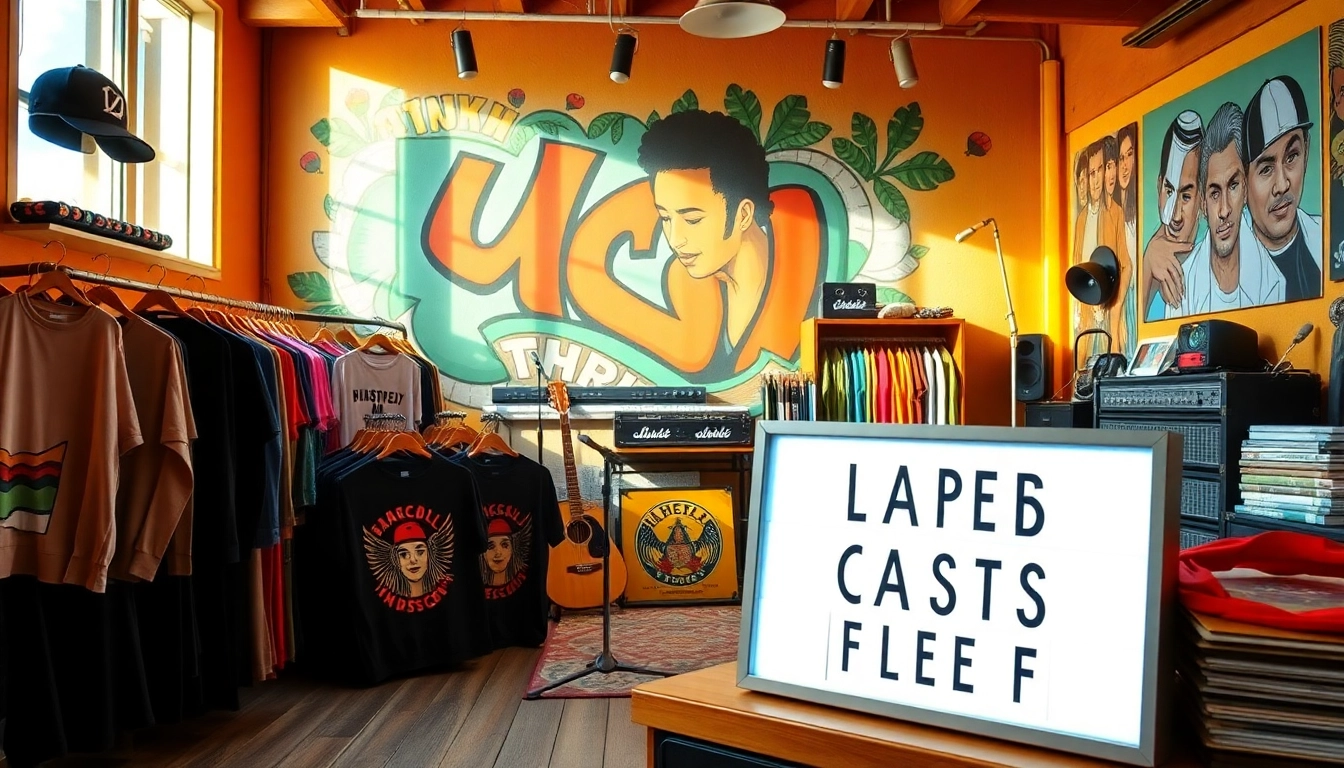Introduction to Merchandise: Why It Matters
Merchandise is more than just a product for sale; it is a crucial extension of an artist’s brand and identity. For music artists, merchandise serves as a tangible connection between the artist and their fans, allowing followers to express their allegiance and support. In today’s digital landscape, where streaming services dominate, the role of merchandise in generating revenue and fortifying brand loyalty has only grown. With the right approach, merchandise can make a significant impact not just on sales figures, but also on fan engagement and community building.
The Role of Merchandise in Brand Identity
Merchandise plays a pivotal role in fostering an artist’s brand identity. Well-designed products reflect the essence of the music, artistic vision, and personality of the performer. For example, band T-shirts often feature artwork, lyrics, or graphics that resonate with the music and can evoke emotions among consumers. This act of wearing merchandise transforms fans into walking billboards, promoting the artist wherever they go.
How Merchandise Boosts Fan Engagement
Engaging with fans through merchandise can enhance the overall emotional connection they have with an artist. For many fans, owning merchandise is a form of affirmation; it signifies belonging to a community. Through exclusive items, limited edition products, and unique offerings, artists can create a sense of urgency and excitement. For instance, offering a special edition vinyl record during a concert can turn an ordinary show into a memorable experience. The availability of merchandise can elevate the artist’s perceived value and create loyal customers invested in supporting their journey.
Understanding Merchandise Trends and Preferences
To maximize merchandise potential, understanding current trends and fan preferences is essential. This involves keeping an eye on what types of products are gaining popularity within the music community, which can vary from artist to artist. For instance, eco-friendly merchandise has emerged as a significant trend, appealing to fans who prioritize sustainability. These insights allow artists to craft offerings that resonate more deeply with their audience, ensuring that products not only reflect the brand but also meet consumer expectations.
Types of Merchandise to Consider
Apparel: Creating Wearable Brand Ambassadors
Clothing is arguably the most popular category of merchandise. Apparel enables fans to showcase their affection for an artist or band and is highly favored because it translates well into casual, everyday wear. From T-shirts and hoodies to caps and socks, apparel options are endless. It’s essential to design pieces that reflect the music’s identity while being fashionable and comfortable. A successful example is the rise of streetwear among musicians, often featuring unique graphics that align with current style trends.
Collectibles: Limited-Edition Items That Excite
Collectibles create a sense of exclusivity and anticipation. Limited-edition releases of vinyl records, autographed posters, or special memorabilia can create significant hype among fans. Investments in quality production and authentic autographs can turn these items into prized possessions. Many collectors enjoy the thrill of the hunt, and catering to this demographic can lead to higher profit margins. The rarity of these items often enhances their value, making them sought after even years after release.
Digital Merchandise: Expanding the Experience Online
In today’s digital age, virtual goods represent an exciting frontier for merchandise sales. Digital downloads, exclusive content like behind-the-scenes videos, and virtual meet-and-greets are emerging trends. Offering digital merchandise allows artists to reach global audiences effectively. Moreover, the production costs are minimal compared to physical goods, which can increase margins. Digital merchandise can also easily adapt to fan preferences, creating customizable offerings based on audience feedback.
Design Best Practices for Merchandise
Choosing the Right Aesthetic for Your Brand
Consistency in aesthetic is essential for merchandise design. The visuals should align seamlessly with the music genre and brand image. Conducting thorough research about the target audience’s preferences can yield impressive results. Collaborating with skilled designers can help articulate the brand’s unique voice through striking visuals and creative designs. It’s also important to consider the longevity of the design’s appeal; timeless styles often endure longer than trendy, fast-fleeting aesthetics.
Incorporating Feedback to Enhance Appeal
Listening to fan feedback can significantly improve the merchandise offerings and overall customer experience. Gathering insights through surveys or social media polls allows artists to understand what their audience desires. Before launching a new product line, testing designs with select fan groups can provide valuable feedback. Utilizing this engagement fosters a community feeling, resulting in fans feeling more connected to the product and increasing the likelihood of purchase.
Balancing Quality and Affordability in Production
When creating merchandise, striking a balance between quality and affordability is vital. Quality materials can ensure longer-lasting products, leading to higher customer satisfaction. However, this should not compromise affordability, especially for younger fans who may have limited budgets. Collaborating with reliable manufacturers who offer competitive pricing without sacrificing fabric quality is essential. Exploring different vendors and production countries may present opportunities to optimize costs while maintaining high standards.
Marketing Your Merchandise Effectively
Leveraging Social Media for Merchandise Promotion
Social media can serve as a powerful tool for promoting merchandise. Platforms such as Instagram, TikTok, and Twitter offer direct communication with fans, enabling tailored marketing strategies. Creating engaging content that showcases the merchandise uniquely can grab attention and encourage sharing. Strategies may involve live sessions where artists present their merchandise, which can create buzz and excitement as fans anticipate new product launches.
Collaborations: Partnering for Greater Reach
Collaboration with other artists, influencers, or brands can amplify merchandise exposure. By aligning with complementary creators or brands, artists can tap into different fan bases, expanding their reach. A crossover merchandise line with another popular artist or brand can lead to innovative designs and heightened interest. Collaborations should resonate with both audiences and must enhance the artist’s brand identity while still attracting the target demographic.
Creating Exclusive Launch Events to Drive Sales
Hosting exclusive launch events can build hype around new merchandise. These events, whether virtual or in-person, can include special performances or interactive activities. Creating a sense of urgency with limited products available on release day can stimulate impulse buying. Consideration for themes that reflect the artist’s current project or tour can enhance the experience, making fans feel part of something exceptional.
Measuring Merchandise Performance
Setting Key Metrics for Success
For any merchandise strategy to be effective, it is essential to establish clear metrics for success. These may include sales targets, conversion rates, and customer retention statistics. By tracking these metrics, artists can gain valuable insights into which products resonate most significantly with their audience, allowing them to adapt future offerings accordingly. Utilizing e-commerce platforms that provide in-depth analytics can contribute to informed decision-making regarding inventory and marketing strategies.
Gathering Customer Insights and Feedback
Consistent collection of customer insights is crucial for evolving merchandise strategies. Encouraging customer feedback through various channels—including surveys and social media interactions—provides a comprehensive view of fans’ wants and needs. Additionally, post-purchase feedback can shed light on overall satisfaction levels and highlight areas for improvement. Leveraging this feedback allows for ongoing refinement of merchandise offerings based on real consumer experiences.
Iterating on Your Merchandise Strategy Based on Data
Flexibility is vital within the merchandise strategy. Regular evaluations based on collected data can help identify trends, successes, and areas needing improvement. A willingness to adapt to changing preferences can position an artist favorably within their industry. By implementing a testing approach—introducing new merchandise concepts on a small scale, analyzing performance and scaling successful initiatives—artists can maintain relevance and satisfy consumer demand effectively.



